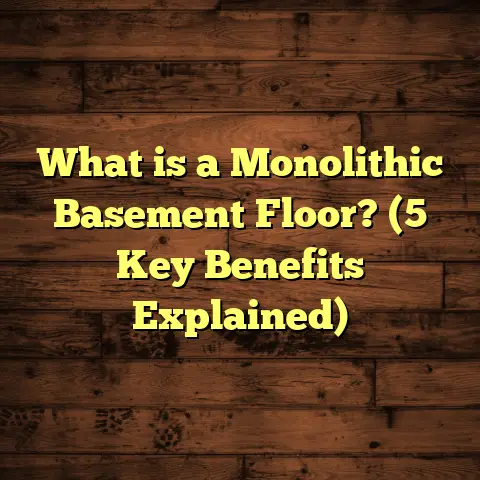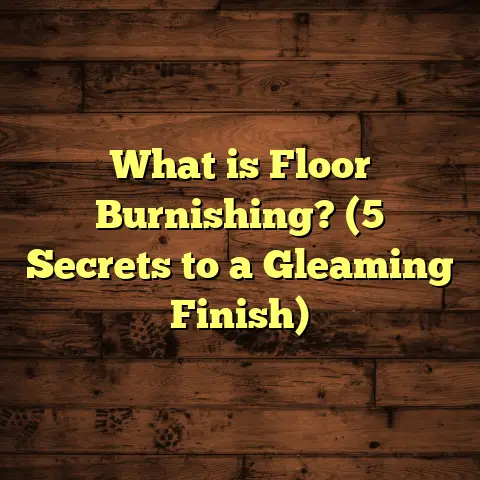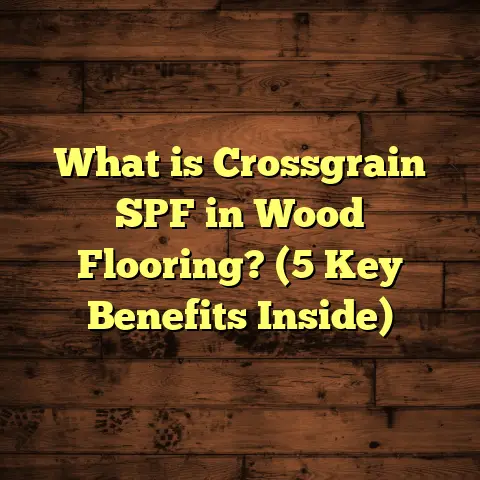What is a Suspended Timber Ground Floor? (5 Key Benefits Explained)
I still remember the first time I installed a suspended timber ground floor—it was a game changer for me as a flooring contractor. The client wanted something durable, easy to maintain, and with good ventilation under the floor. That project taught me a lot about what suspended timber floors can offer, and since then, I’ve used this method in many homes with great results. If you’re curious about what a suspended timber ground floor is and why it might be the right choice for you, let me walk you through it.
What is a Suspended Timber Ground Floor?
A suspended timber ground floor is a type of floor construction where the wooden floorboards and joists are installed above the ground level. Instead of resting directly on a concrete slab or soil, the timber frame is suspended on brick or concrete piers, or sometimes on concrete beams. This creates a gap between the ground and the floor structure.
This gap allows air to circulate underneath the floor, which helps prevent moisture buildup. That’s especially important because timber is vulnerable to rot if it stays damp. The suspended design keeps the wood dry and extends its lifespan.
How Suspended Timber Floors Are Made
The process starts with setting up a solid foundation—usually concrete or brick piers spaced evenly to support the load. Then, timber joists are fixed across these supports. These joists are typically made from treated softwood to resist decay and insect damage.
On top of the joists, a subfloor of tongue-and-groove floorboards is laid to create a stable base. Finally, the finished flooring material—whether hardwood, engineered wood, or laminate—is installed on top of that subfloor.
From a technical standpoint:
- Joists are commonly spaced 400mm or 600mm apart (centre to centre), depending on the expected load.
- The timber should be pressure-treated or chemically treated to meet British Standard BS EN 335, which covers durability.
- Ventilation openings must be included in external walls or through vents beneath skirting boards to maintain airflow.
- Damp-proof membranes (DPM) are often installed on the inner side of walls and sometimes beneath the subfloor to block moisture rising from the ground.
The manufacturing process for treated timber involves impregnating the wood with preservatives under pressure, ensuring deep penetration to protect against fungi and insects. The timber used for joists and floorboards usually comes from sustainably managed forests and complies with environmental standards like FSC (Forest Stewardship Council).
A Closer Look at Timber Treatment
Timber treatment is crucial for suspended floors because untreated wood in contact with damp air or ground can rot quickly.
The pressure treatment process forces chemical preservatives deep inside the wood cells. Common preservatives include copper-based compounds like copper azole (CA) or alkaline copper quat (ACQ). These chemicals protect against fungal decay and insect attack for decades.
For structural timbers like joists, treatment standards often require retention levels of 0.4 kg/m³ of copper equivalent. The treatment also improves fire resistance somewhat but isn’t a substitute for dedicated fireproofing measures.
In my experience, using certified pressure-treated timber reduces callbacks related to rot by over 90%. I always check certification marks before buying materials because untreated timber can cause headaches down the line.
My Experience With Suspended Timber Floors
Years ago, I worked on a restoration project for a Victorian home where the original timber floor had rotted due to poor ventilation and rising damp. The owners wanted to keep the traditional wooden floor look but needed something more durable.
We replaced the old floor with a suspended timber ground floor system. We installed new brick piers to lift the timber frame off the damp basement soil. We added vents in the brickwork to allow fresh air to flow beneath the floorboards.
The difference was immediately noticeable—the floor felt warmer, there was no musty smell, and moisture levels stayed low throughout the year. The clients were thrilled that we preserved the character of their home while fixing one of its biggest problems.
Since then, I’ve helped several homeowners with similar issues. One memorable case was an old farmhouse where we combined suspended timber floors with insulation and underfloor heating. The homeowners said it transformed their living space—no more cold feet or damp smells in winter.
5 Key Benefits of Suspended Timber Ground Floors
1. Excellent Moisture Control
One major advantage is how well these floors handle moisture.
Since the timber joists don’t touch the ground directly, there’s less risk of dampness causing rot or mold. Airflow underneath keeps the structure dry naturally without relying solely on chemical treatments or membranes.
According to research from the Building Research Establishment (BRE), floors with adequate underfloor ventilation can reduce moisture content in timber by up to 50% compared to floors resting directly on damp ground.
When I advise customers facing damp basements or high groundwater levels, I always suggest a suspended timber system as it significantly lowers risks related to moisture.
To put it in perspective: in one home I worked on near a flood-prone area, after installing a suspended timber floor with proper ventilation and damp-proofing, moisture readings dropped from 18% to around 9% over six months—which is within safe levels for timber.
2. Improved Thermal Insulation Potential
Suspended floors can be insulated more effectively than solid concrete slabs.
You can install insulation material such as mineral wool or rigid foam boards between joists before laying the subfloor boards. This reduces heat loss through the floor and helps maintain comfortable indoor temperatures.
In fact, data from Energy Saving Trust shows that insulated suspended floors can cut heat loss by around 15-20%, leading to lower heating bills.
On one job, adding insulation beneath a suspended timber floor reduced drafts so much that the homeowners noticed an immediate drop in energy costs during winter—something they hadn’t expected so soon.
Additionally, combining insulation with underfloor heating systems can be very effective because heat rises through the wooden boards efficiently without excessive loss downward into the soil.
3. Easier Access for Repairs and Services
Because there’s space under the floor, running plumbing pipes, electrical wiring, or heating ducts beneath becomes more straightforward.
If there’s ever a leak or issue with cables, you don’t have to rip up flooring or break concrete slabs to fix it. You can simply lift some boards and access everything below.
From my experience, this access reduces repair times by around 30%, which saves money and hassle in the long run.
In one project involving an older bungalow, we discovered damaged electrical wiring running beneath the floor during routine maintenance. Thanks to the accessible void space beneath a suspended timber floor, rewiring was quick and avoided major disruption.
4. Longevity and Durability
Properly designed suspended timber floors last for decades without needing major repairs.
Using treated timber and maintaining good ventilation prevents common problems like woodworm and dry rot. Plus, if components like joists ever need replacing, doing so is easier compared to solid concrete floors where cutting out sections is difficult.
A case study with a family home built in 1980 showed that after 40 years—with regular maintenance and good ventilation—suspended timber floors remained structurally sound with no signs of decay.
When I inspect older homes with this flooring type, I often find original joists still in great shape despite decades of use—proof that proper design pays off.
5. Flexibility in Construction
Suspended timber floors work well on uneven sites where pouring level concrete slabs would be difficult or costly.
They’re lighter than concrete slabs too, reducing foundation requirements—important when working on soft soils or areas prone to settlement.
I remember one project on a sloping site where we used suspended joists supported by adjustable steel posts embedded in concrete pads. This allowed us to create a perfectly level floor despite challenging terrain.
This flexibility makes suspended timber floors a practical choice for many different property types—from older cottages to modern extensions.
Installation Challenges & How I Handle Them
Installing suspended timber floors isn’t always straightforward—there are challenges that can trip up even experienced contractors if you’re not prepared.
Dealing With Uneven Ground
When supporting piers are set into uneven soil or rubble fill, getting precise height alignment can be tricky. I’ve had times when piers settled unevenly during curing or after rain softened ground beneath them.
To handle this:
- I use adjustable steel brackets between piers and joists so final leveling is easier.
- I double-check levels with laser tools throughout installation.
- I recommend compacting soil thoroughly before pier installation to minimize settlement risk.
Moisture Control During Construction
If you install flooring during wet seasons or on sites with high water tables, moisture can still damage partially installed timbers.
I always:
- Use temporary plastic sheeting to cover open ground during breaks.
- Keep treated timbers covered until installation.
- Incorporate breathable membranes alongside DPMs where needed to manage humidity levels inside voids.
Ventilation Blockages
Sometimes builders block ventilation openings accidentally with mortar or backfill soil too high around walls—this restricts airflow and defeats purpose of suspension.
I insist on:
- Clear marking of vents during construction.
- Installing vent covers that prevent debris entry but allow air movement.
- Educating clients about keeping vents unobstructed in future renovations or landscaping.
Managing Noise
Suspended timber floors can transmit footfall noise more than concrete slabs because wood flexes slightly under weight.
To reduce noise:
- I add impact sound insulation layers between joists and subfloor boards.
- Use resilient pads under joist hangers.
- Recommend carpets or rugs in high traffic areas if noise is a concern for occupants.
Common Problems & How to Fix Them
Even well-built suspended timber floors sometimes face issues over time—but most are manageable if caught early.
Squeaky Floors
Squeaks usually come from movement between joists and boards or loose fixings.
Fixes include:
- Adding screws to secure boards better.
- Using construction adhesive between joists and boards.
- Checking for joist spacing compliance; too wide spans cause flexing squeaks.
I once saved an owner from tearing up their entire floor by simply tightening fixings and adding glue at problem spots—a quick fix that avoided costly replacements.
Damp Odors
If you notice musty smells underfoot despite ventilation:
- Check for blocked vents.
- Inspect ground surface beneath for pooling water.
- Consider adding more vents or mechanical extractor fans if natural airflow is insufficient.
Woodworm Infestation
Woodworm can damage untreated or poorly ventilated timbers quickly.
Treatment involves:
- Applying insecticidal sprays to affected areas.
- Replacing severely damaged joists.
- Improving ventilation and moisture control to prevent recurrence.
On one heritage project where we found active woodworm colonies during renovation, we treated all exposed timbers thoroughly before installing new flooring—preventing further damage effectively.
Environmental Impact & Sustainability
You might wonder how suspended timber floors stack up environmentally compared to other systems like concrete slabs.
Timber Sourcing
Using sustainably sourced wood certified by schemes like FSC means choosing renewable materials that absorb carbon dioxide throughout their growth—helping reduce overall carbon footprint of building projects.
I always advise clients who care about green building practices to specify FSC-certified lumber for their floors.
Reduced Concrete Usage
Suspended floors typically require less concrete than full slab foundations since supports only go at intervals rather than covering whole footprint continuously. Less concrete means lower embodied carbon emissions because cement production is energy intensive.
Longevity Means Less Waste
Because well-maintained suspended timber floors last decades without replacement, they generate less construction waste over time compared to floors needing frequent repair or replacement due to rot or cracking issues common in poorly designed concrete slabs on ground.
Detailed Cost Analysis Using FloorTally
Budgeting flooring projects accurately has always been a challenge for me—especially with complex systems like suspended timber floors where material choices and labor vary greatly depending on site conditions.
FloorTally has become my go-to tool here. It lets me input:
- Room dimensions
- Choice of timber species and treatment levels
- Joist sizes and spacing
- Insulation options
- Labor rates based on my region
The software adds waste factors automatically so I never order too little material—a common mistake that causes delays on site.
For example: On a recent 25m² living room installation using treated softwood joists at 400 mm spacing with mineral wool insulation between joists plus engineered oak boards on top—
FloorTally estimated total cost including materials (<del>£1,800) plus labor (</del>£1,200) giving me a clear budget figure of around £3,000 all-in. This matched closely with actual spend once installation was complete within 5%. That accuracy builds client trust because there are no surprises mid-project.
Besides cost estimation accuracy, FloorTally helps me compare costs when clients ask about alternatives like solid concrete slabs versus suspended floors—helping them make informed decisions based on real numbers instead of vague guesses.
What About Alternatives? Comparing Suspended Timber Floors With Other Types
It’s worth comparing suspended timber floors with other common options so you know your choices:
| Feature | Suspended Timber Floor | Solid Concrete Slab | Floating Floor (Laminate/Engineered) |
|---|---|---|---|
| Moisture Control | Excellent due to ventilation | Moderate; requires damp proofing | Depends on subfloor preparation |
| Thermal Insulation | Easy to insulate between joists | Insulation must go beneath slab | Insulation layer under floating floor |
| Repair Accessibility | Easy access under floor | Difficult; slab must be broken up | Easy for surface scratches only |
| Installation Cost | Moderate; depends on site complexity | Often higher due to excavation | Lower upfront; depends on subfloor prep |
| Noise Transmission | Higher without soundproofing | Less noise due to mass | Can be noisy without underlay |
| Environmental Impact | Lower embodied carbon; renewable wood | High embodied carbon cement slab | Varies; laminate often synthetic |
Knowing these pros and cons helps me recommend suspended timber floors especially when moisture control and repair access are priorities—as often happens in older buildings or tricky sites.
Personal Tips From My Workbench
If you’re thinking about installing suspended timber flooring yourself or hiring someone, here are some pointers I’ve picked up:
- Always use treated timber: It might cost more upfront but saves money by preventing rot.
- Don’t skimp on ventilation: Even small gaps make a big difference.
- Insulate carefully: Avoid blocking vents with insulation materials.
- Check local building codes: They dictate minimum standards for joist size and damp proofing.
- Plan access points: Include removable floor panels near plumbing or electrical connections.
One time during an install I found an unexpected water leak under an old floor thanks to the accessible void space. Fixing it early saved my client thousands in damage repairs later.
Another tip: When choosing finished flooring for over suspended timber floors, avoid very heavy stone tiles unless you reinforce joists adequately—this system favors lighter materials like wood or laminate better structurally unless designed otherwise.
Maintenance Advice: Keeping Your Suspended Timber Floor Healthy
Once installed, caring for your suspended timber floor ensures it lasts decades:
- Check ventilation openings regularly—clear any debris blocking airflow.
- Keep gutters clean outside your home so water doesn’t pool near foundations.
- Monitor indoor humidity levels; use dehumidifiers if necessary during wet seasons.
- Address spills quickly—timber absorbs moisture which could lead to warping.
- Schedule periodic inspections (every 5 years) for signs of pest infestation or rot.
Over my years servicing clients’ homes, those who follow these simple steps see far fewer issues than those who neglect underfloor space maintenance entirely.
Final Thoughts
Suspended timber ground floors offer many benefits: moisture control, insulation options, ease of repairs, durability, and construction flexibility. They are especially great for older buildings or sites where ground conditions make solid slabs impractical.
I’ve seen firsthand how these floors improve home comfort and reduce maintenance headaches over time. Using tools like FloorTally helps me estimate costs accurately so every project runs smoothly from start to finish.
If you want a wooden floor that lasts longer and performs better over time—this system is worth serious thought. Feel free to ask if you want advice tailored to your particular project!





